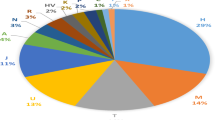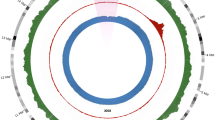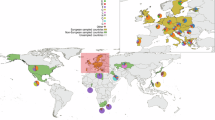Abstract
The relative roles of natural selection and accentuated genetic drift as explanations for the high frequency of more than 20 Ashkenazi Jewish disease alleles remain controversial. To test for the effects of a maternal bottleneck on the Ashkenazi Jewish population, we performed an extensive analysis of mitochondrial DNA (mtDNA) hypervariable segment 1 (HVS-1) sequence and restriction site polymorphisms in 565 Ashkenazi Jews from different parts of Europe. These patterns of variation were compared with those of five Near Eastern (n=327) and 10 host European (n=849) non-Jewish populations. Only four mtDNA haplogroups (Hgs) (defined on the basis of diagnostic coding region RFLPs and HVS-1 sequence variants) account for ∼70% of Ashkenazi mtDNA variation. While several Ashkenazi Jewish mtDNA Hgs appear to derive from the Near East, there is also evidence for a low level of introgression from host European non-Jewish populations. HVS-1 sequence analysis revealed increased frequencies of Ashkenazi Jewish haplotypes that are rare or absent in other populations, and a reduced number of singletons in the Ashkenazi Jewish sample. These diversity patterns provide evidence for a prolonged period of low effective size in the history of the Ashkenazi population. The data best fit a model of an early bottleneck (∼100 generations ago), perhaps corresponding to initial migrations of ancestral Ashkenazim in the Near East or to Europe. A genetic bottleneck followed by the recent phenomenon of rapid population growth are likely to have produced the conditions that led to the high frequency of many genetic disease alleles in the Ashkenazi population.
Similar content being viewed by others
Log in or create a free account to read this content
Gain free access to this article, as well as selected content from this journal and more on nature.com
or
References
Ben-Sasson HH : History of the Jewish People. Cambridge: Harvard University Press; 1976.
Goodman RM : Genetic Disorders Among the Jewish People. Baltimore: The Johns Hopkins University Press; 1979.
Weinryb BD : The Jews of Poland: a Social and Economic History of the Jewish Community of Poland From 1100 to 1800. Philadelphia: The Jewish Publication Society of America; 1972.
Dellapergola S : Major demographic trends of world Jewry: the last hundred years. in Adam A (ed): Genetic Diversity Among Jews. New York: Oxford University Press; 1992; Chapter 1: pp 3–30.
Jorde LB : Population diseases in the Ashkenazi population: evolutionary considerations. in Bonne-Tamir B, Adam A (eds): Genetic Diversity Among Jews. New York, Oxford University Press; 1992, pp 305–312.
Risch N, de Leon D, Ozelius L et al: Genetic analysis of idiopathic torsion dystonia in Ashkenazi Jews and their recent descent from a small founder population. Nat Genet 1995; 9: 152–159.
Goldstein DB, Reich DE, Bradman N, Usher S, Seligsohn U, Peretz H : Age estimates of two common mutations causing factor XI deficiency: recent genetic drift is not necessary for elevated disease incidence among Ashkenazi Jews. Am J Hum Genet 1999; 64: 1071–1075.
Fay JC, Wu CI : A human population bottleneck can account for the discordance between patterns of mitochondrial versus nuclear DNA variation. Mol Biol Evol 1999; 16: 1003–1005.
Santachiara Benerecetti AS, Semino O, Passarino G et al: The common, Near-Eastern origin of Ashkenazi and Sephardi Jews supported by Y-chromosome similarity. Ann Hum Genet 1993; 57: 55–64.
Hammer MF, Redd AJ, Wood ET et al: Jewish and middle eastern non-jewish populations share a common pool of Y-chromosome biallelic haplotypes (in process citation). Proc Natl Acad Sci USA 2000; 97: 6769–6774.
Nebel A, Filon D, Brinkmann B, Majumder PP, Faerman M, Oppenheim A : The Y chromosome pool of Jews as part of the genetic landscape of the Middle East. Am J Hum Genet 2001; 69: 1095–1112.
Thomas MG, Weale ME, Jones AL et al: Founding mothers of Jewish communities: geographically separated Jewish groups were independently founded by very few female ancestors. Am J Hum Genet 2002; 70: 1411–1420.
Excoffier L, Schneider S : Why hunter-gatherer populations do not show signs of pleistocene demographic expansions. Proc. Natl. Acad. Sci. USA 1999; 96: 10597–10602.
Richards M, Macaulay V, Hickey E et al: Tracing European founder lineages in the Near Eastern mtDNA pool. Am J Hum Genet 2000; 67: 1251–1276.
Macaulay V, Richards M, Hickey E et al: The emerging tree of West Eurasian mtDNAs: a synthesis of control-region sequences and RFLPs. Am J Hum Genet 1999; 64: 232–249.
Quintana-Murci L, Semino O, Bandelt HJ, Passarino G, McElreavey K, Santachiara-Benerecetti AS : Genetic evidence of an early exit of Homo sapiens sapiens from Africa through eastern Africa. Nat Genet 1999; 23: 437–441.
Schneider S, Roessli D, Excoffier L : Arlequin Software for Population Genetic Analysis. Geneva: Genetics and Biometry Laboratory, University of Geneva; 2000.
Fu Y : Statistical tests of neutrality of mutations against population growth, hitchhiking and background selection. Genetics 1997; 147: pp 915–925.
Rogers A, Harpending HC : Population growth makes waves in the distribution of pairwise differences. Mol Biol Evol 1992; 9: 552–569.
Bandelt HJ, Forster P, Rohl A : Median-joining networks for inferring intraspecific phylogenies. Mol Biol Evol 1999; 16: 37–48.
Kruskal JB : Multidimensional scaling by optimizing goodness of fit to a nonmetric hypothesis. Pyschometrika 1964; 29: 1–27.
Rohlf FJ : NTSYS-pc: Numerical Taxonomy and Multivariate Analysis System. Setauket, NY: Exeter Software; 1998.
Rogers AR : Genetic evidence for a Pleistocene population explosion. Evolution 1995; 49: 608–615.
Excoffier L, Schneider S : Why hunter-gatherer populations do not show signs of pleistocene demographic expansions. Proc Natl Acad Sci USA 1999; 96: 10597–10602.
Cordaux R, Saha N, Bentley GR, Aunger R, Sirajuddin SM, Stoneking M : Mitochondrial DNA analysis reveals diverse histories of tribal populations from India. Eur J Hum Genet 2003; 11: 253–264.
Durst R, Colombo R, Shpitzen S et al: Recent origin and spread of a common Lithuanian mutation, G197del LDLR, causing familial hypercholesterolemia: positive selection is not always necessary to account for disease incidence among Ashkenazi Jews. Am J Hum Genet 2001; 68: 1172–1188.
Weinryb BD : The Jews of Poland: a Social and Economic History of the Jewish Community in Poland From 1100 to 1800. Philadelphia: The Jewish Publication Society of America; 1972.
Chakravarti A, Chakraborty R : Elevated frequency of Tay-Sachs disease among Ashkenazic Jews unlikely by genetic drift alone. Am J Hum Genet 1978; 30: 256–261.
Motulsky AG : Possible selective effects of urbanization on Ashkenazi Jews. in Goodman RM, Motulsky AG (eds): Genetic Diseases Among Ashkenazi Jews. New York: Raven Press; 1979, pp 301–314.
Diamond JM : Human Genetics. Jewish Lysosomes. Nature 1994; 368: 291–292.
Rogers AR, Harpending HC : Population growth makes waves in the distribution of pairwise differences. Mol Biol Evol 1992; 9: 552–569.
DiRienzo A, Wilson AC : Branching pattern in the evolutionary tree for human mitochondrial DNA. Proc Natl Acad Sci USA 1991; 88: 1597–1601.
Slatkin M, Hudson RR : Pairwise comparisons of mitochondrial DNA sequences in stable and exponentially growing populations. Genetics 1991; 129: 555–562.
Rogers AR, Jorde LB : Genetic evidence on modern human origins. Hum Biol 1995; 67: 1–36.
Harpending HC, Sherry ST, Rogers AR, Stoneking M : The genetic-structure of ancient human-populations. Curr Anthropol 1993; 34: 483–496.
Ward RH, Frazier BL, Dew-Jager K, Paabo S : Extensive mitochondrial diversity within a single Amerindian tribe. Proc Natl Acad Sci USA 1991; 88: 8720–8724.
Wall JD, Przeworski M : When did the human population size start increasing? Genetics 2000; 155: 1865–1874.
Pluzhnikov A, Di Rienzo A, Hudson RR : Inferences about human demography based on multilocus analyses of noncoding sequences. Genetics 2002; 161: 1209–1218.
Baldwin CT, Weiss S, Farrer LA et al: Linkage of congenital, recessive deafness (DFNB4) to chromosome 7q31 and evidence for genetic heterogeneity in the Middle Eastern Druze population. Hum Mol Genet 1995; 4: 1637–1642.
Goldstein DB, Reich DE, Bradman N, Usher S, Seligsohn U, Peretz H : Age estimates of two common mutations causing factor XI deficiency: recent genetic drift is not necessary for elevated disease incidence among Ashkenazi Jews. Am J Hum Genet 1999; 64: 1071–1075.
Ostrer H : A genetic profile of contemporary Jewish populations. Nat Rev Genet 2001; 2: 891–898.
Ellis NA, Ciocci S, Proytcheva M, Lennon D, Groden J, German J : The Ashkenazic Jewish Bloom syndrome mutation blmAsh is present in non-Jewish Americans of Spanish ancestry. Am J Hum Genet 1998; 63: 1685–1693.
Diaz GA, Gelb BD, Risch N et al: Gaucher disease: the origins of the Ashkenazi Jewish N370S and 84GG acid beta-glucosidase mutations. Am J Hum Genet 2000; 66: 1821–1832.
Bar-Sade RB, Kruglikova A, Modan B et al: The 185delAG BRCA1 mutation originated before the dispersion of Jews in the diaspora and is not limited to Ashkenazim. Hum Mol Genet 1998; 7: 801–805.
Patael Y, Figer A, Gershoni-Baruch R et al: Common origin of the I1307K APC polymorphism in Ashkenazi and non-Ashkenazi Jews. Eur J Hum Genet 1999; 7: 555–559.
Ohta T : Slightly deleterious mutant substitutions in evolution. Nature 1973; 246: 96–98.
Acknowledgements
We thank Laurent Excoffier for valuable comments, Dr Marc-Alain Levy for help in collecting samples from the French Rhine Valley, the National Laboratory for the Genetics of Israeli Populations for contributing samples to this study and David Goldstein for providing non-Ashkenazi Jewish mtDNA data. This work was supported by a grant from the National Institute of General Medical Sciences (GM53566-06) to MH and an award grant from the Israeli Science Foundation to KS, as well as a kind donation from the Milin Charitable Foundation.
Author information
Authors and Affiliations
Corresponding author
Additional information
(Supplementary information accompanies the paper on European Journal of Human Genetics website (http://www.nature.com/ejhg))
Supplementary information
Rights and permissions
About this article
Cite this article
Behar, D., Hammer, M., Garrigan, D. et al. MtDNA evidence for a genetic bottleneck in the early history of the Ashkenazi Jewish population. Eur J Hum Genet 12, 355–364 (2004). https://doi.org/10.1038/sj.ejhg.5201156
Received:
Revised:
Accepted:
Published:
Issue date:
DOI: https://doi.org/10.1038/sj.ejhg.5201156
Keywords
This article is cited by
-
Genetic and phylogeographic evidence for Jewish Holocaust victims at the Sobibór death camp
Genome Biology (2021)
-
Middle eastern genetic legacy in the paternal and maternal gene pools of Chuetas
Scientific Reports (2020)



